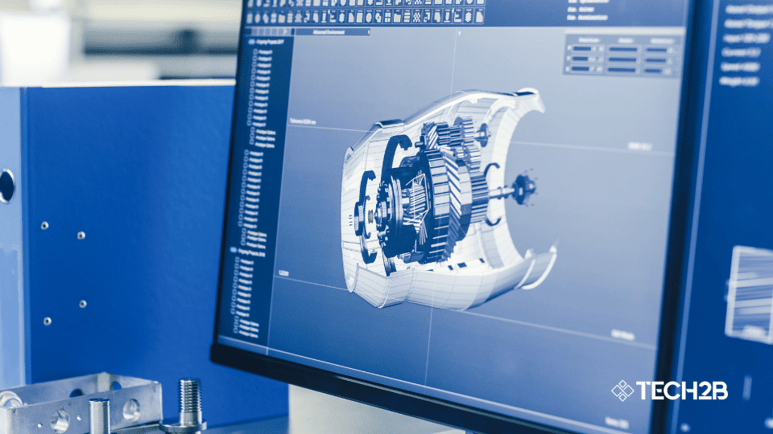Digital spare parts: Manufacturing's solution to supply chain woes
Door Tech2B op Apr 26, 2024 11:44:09 AM

The manufacturing sector has long been the backbone of global economies, powering everything from everyday consumer goods to critical infrastructure. However, the sector has faced significant challenges in recent decades, including supply chain disruptions and the escalating costs of warehousing. A promising solution to these issues is emerging in the form of digital spare parts. This innovative approach not only promises to streamline operations but also ensures the longevity and efficiency of manufacturing processes. In this article, we will explore how digital spare parts are transforming the industry, the technology behind them, and the benefits they offer to modern manufacturing.
The rise of digital spare parts
Historical context and the need for innovation
Following the Second World War, the golden age of manufacturing saw massive industrial growth. However, as plants aged and jobs shifted overseas, maintaining operational efficiency with aging equipment became increasingly difficult. Today, the manufacturing industry is revisiting its strategies to overcome these long-standing challenges.
Understanding digital spare parts
Digital spare parts represent a paradigm shift in how we think about manufacturing and equipment maintenance. These parts are created using advanced manufacturing techniques such as 3D printing, which allows for the rapid production of parts on-demand, reducing the need for extensive inventories.
Technology driving digital spare parts
Advanced manufacturing techniques
Key technologies such as additive manufacturing (AM), CNC milling, and rapid casting are at the forefront of this revolution. These methods allow for quicker production cycles and are less resource-intensive compared to traditional manufacturing processes.
The role of digital twins
Digital twins play a crucial role in the digital spare parts ecosystem. These are digital replicas of physical parts that can be used for testing, simulation, and direct manufacturing, significantly speeding up the design and production phases.
Benefits of digital spare parts
Reducing lead times and costs
One of the most significant advantages of digital spare parts is their ability to reduce lead times and costs associated with traditional supply chains, which is particularly beneficial in a post-COVID-19 economic landscape.
Enhancing supply chain resilience
By leveraging digital inventories and on-demand manufacturing, companies can significantly reduce their dependency on complex supply chains, enhancing overall resilience and responsiveness to market changes.
Case studies and real-world applications
Energy and defense sectors
These sectors have successfully integrated digital spare parts to address their unique challenges. The defense industry, for example, has improved logistics and supply chain efficiency by adopting advanced manufacturing technologies for critical components.
Innovative projects and collaborations
Organizations like Wichita State University’s National Institute for Aviation Research (NIAR) and the US Marine Corps have embarked on projects to digitize parts and create digital inventories, setting a precedent for other industries to follow.
The future of digital spare parts in manufacturing
Strategic implementation for industry adoption
For widespread adoption, industries must identify and prioritize parts that can be digitized and integrate digital spare parts into their maintenance and production strategies.
Investing in advanced manufacturing capabilities
As industries continue to evolve, investing in new manufacturing capabilities will be essential for sustaining and enhancing the operational viability of existing and future equipment.
Conclusion
The adoption of digital spare parts is more than a mere technological upgrade; it is a strategic move towards more sustainable, efficient, and cost-effective manufacturing practices. As we look towards the future, the integration of these technologies will not only solve existing operational challenges but also pave the way for the next generation of manufacturing innovation. This transformation, driven by digital spare parts, promises to make manufacturing systems more robust, agile, and capable of meeting the demands of the modern world.
Frequently Asked Questions
Digital spare parts are digitally stored and transferred manufacturing data for components that can be produced on demand using advanced manufacturing techniques such as 3D printing. This approach allows companies to maintain a digital inventory rather than physical stock, significantly reducing warehousing costs and improving response times to part needs.
Digital spare parts enhance supply chain efficiency by reducing the reliance on extensive physical inventories and long lead times associated with traditional manufacturing. Since parts can be produced quickly and on-demand using digital files, manufacturers can respond more swiftly to market changes and equipment failures, minimizing downtime and logistical hurdles.
The primary technologies used to create digital spare parts include additive manufacturing (3D printing), CNC milling, and rapid casting. These technologies enable the production of parts directly from digital designs, which can be adjusted and optimized without the need for costly and time-consuming traditional tooling processes.
Yes, digital spare parts are versatile and can be applied across various industries, especially those with high dependence on machinery and equipment such as automotive, aerospace, defense, and energy. These sectors benefit significantly from the ability to produce parts quickly, reducing the risk of operational downtime.
The long-term benefits of adopting digital spare parts include increased operational efficiency, reduced production and inventory costs, enhanced flexibility in manufacturing operations, and improved environmental sustainability by minimizing waste. Additionally, this approach helps companies stay competitive in a fast-evolving market by enabling faster innovation cycles and customized solutions.
Digital twins are accurate digital representations of physical parts used extensively in the realm of digital spare parts. They serve multiple purposes, including performance monitoring, predictive maintenance, and simulation. Using digital twins, manufacturers can test and modify designs virtually before printing them physically, ensuring that the final product is optimized for performance and cost. This not only speeds up the development process but also enhances the reliability and functionality of the manufactured parts.

Nog geen reacties
Laat ons weten wat je denkt